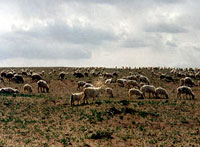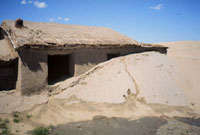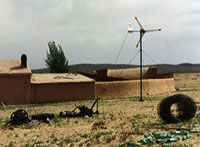Last month, scientists at the National Oceanic and Atmospheric Administration laboratory in Boulder, Colo., reported that a huge dust storm from northern China had reached the U.S. “blanketing areas from Canada to Arizona with a layer of dust.” They reported that along the foothills of the Rockies, the mountains were obscured by the dust from China.
This dust storm did not come as a surprise. In early March, the People’s Daily reported that the season’s first dust storm — one of the earliest on record — had hit Beijing. These dust storms, coupled with last year’s, were among the worst in memory, signaling a widespread deterioration of the rangeland and cropland in the country’s vast northwest.

China’s recent dust storms are
reminiscent of the U.S. Dust Bowl.
Photo: USDA.
Huge dust plumes routinely travel hundreds of miles to populous cities in northeastern China, including Beijing, obscuring the sun, reducing visibility, slowing traffic, and closing airports. Reports of residents in eastern cities caulking windows with old rags to keep out the dust are reminiscent of the U.S. Dust Bowl of the 1930s.
Eastward-moving winds often carry soil from China’s northwest to North Korea, South Korea, and Japan, countries that regularly complain about dustclouds that both filter out the sunlight and cover everything with dust. Responding to pressures from their constituents, a group of 15 legislators from Japan and eight from South Korea is organizing a tri-national committee with Chinese lawmakers to devise a strategy to combat the dust.
News reports typically attribute the dust storms to the drought of the last three years, but the drought is simply bringing a fast-deteriorating situation into focus. Human pressure on the land in northwest China is excessive. There are too many people, too many cattle and sheep, and too many plows. Feeding 1.3 billion people, a population nearly five times that of the United States, is not an easy matter.
A Dust-up
In addition to local pressures on resources, a decision in Beijing in 1994 to require that all cropland used for construction be offset by land reclaimed elsewhere has helped create the ecological disaster that is now unfolding. In an article in Land Use Policy, Chinese geographers Hong Yang and Xiubein Li describe the environmental effects of this offset policy. The fast-growing coastal provinces, such as Guandong, Shandong, Xheijiang, and Jiangsu, which are losing cropland to urban expansion and industrial construction, are paying other provinces to plow new land to offset their losses. This provided an initial economic windfall for provinces in the northwest, such as Inner Mongolia (which led the way with a 22 percent cropland expansion), Gansu, Qinghai, Ningxia, and Xinjiang.

Sheep grazing in Mongolia.
Photo: NREL/PIX.
As the northwestern provinces, already suffering from overplowing and overgrazing, plowed ever more marginal land, wind erosion intensified. Now, accelerating wind erosion of soil and the resulting land abandonment are forcing people to migrate eastward, not unlike the U.S. westward migration from the southern Great Plains to California during the Dust Bowl years.
While plows are clearing land, expanding livestock populations are denuding the land of vegetation. Following economic reforms in 1978 and the removal of controls on the size of herds and flocks that collectives could maintain, livestock populations grew rapidly. Today China has 127 million cattle, compared with 98 million in the U.S. Its flock of 279 million sheep and goats compares with only nine million in the U.S.
In Gonge County in eastern Quinghai Province, the number of sheep that local grasslands can sustain is estimated at 3.7 million, but by the end of 1998, sheep numbers there had reached 5.5 million, far beyond the land’s carrying capacity. The result is fast-deteriorating grassland, desertification, and the formation of sand dunes.

The desert’s a-growing in Mongolia.
Photo: USGS.
In the New York Times, Erik Eckholm reports that “the rising sands are part of a new desert forming here on the eastern edge of the Quinghai-Tibet Plateau, a legendary stretch once known for grass reaching as high as a horse’s belly and home for centuries to ethnic Tibetan herders.” Official estimates show 900 square miles of land going to desert each year. An area several times as large is suffering a decline in productivity as it is degraded by overuse.
In addition to the direct damage from overplowing and overgrazing, the northern half of China is literally drying out as rainfall declines and aquifers are depleted by overpumping. Water tables are falling almost everywhere, gradually altering the region’s hydrology. As water tables fall, springs dry up, streams no longer flow, lakes disappear, and rivers run dry. U.S. satellites, which have been monitoring land use in China for some 30 years, show that literally thousands of lakes in the North have disappeared.
Deforestation in southern and eastern China is reducing the moisture transported inland from the South China Sea, the East China Sea, and the Yellow Sea, writes Wang Hongchang, a fellow at the Chinese Academy of Social Sciences. Where land is forested, the water is held and evaporates to be carried further inland. When tree cover is removed, the initial rainfall from the inland-moving, moisture-laden air simply runs off and returns to the sea. As this recycling of rainfall inland is weakened by deforestation, rainfall in the interior is declining.
The Winds of Change
Reversing this degradation means stabilizing population and planting trees everywhere possible to help recycle rainfall inland. It means converting highly erodible cropland back to grassland or woodland, reducing the livestock population, and planting tree shelter belts across the windswept areas of cropland, as U.S. farmers did to end dust storms in the 1930s.

A wind turbine in Mongolia.
Photo: NREL/PIX.
Another interesting option now presents itself — the use of wind turbines as windbreaks to reduce wind speed and soil erosion. With the cost of wind-generated electricity now competitive with that generated from fossil fuels, constructing rows of wind turbines in strategic areas to slow the wind could greatly reduce the erosion of soil. This also affords an opportunity to phase out the use of wood for fuel, thus lightening the pressure on forests.
The economics are extraordinarily attractive. In the U.S. Great Plains, under conditions similar to China’s northwest, a large, advanced-design wind turbine occupying one-fifth of an acre of land can produce $100,000 of electricity per year. This source of rural economic regeneration fits in nicely with China’s plan to develop the impoverished northwest.
Reversing desertification will require a huge effort, but if the dust bowl continues to spread, it will not only undermine the economy, but also trigger a massive migration eastward. The options are clear: Reduce livestock populations to a sustainable level or face heavy livestock losses as grassland turns to desert. Return highly erodible cropland to grassland or lose all of the land’s productive capacity as it turns to desert. Construct windbreaks with a combination of trees and, where feasible, wind turbines, to slow the wind or face even more soil losses and dust storms.
If China cannot quickly arrest the trends of deterioration, the growth of the dust bowl could acquire an irreversible momentum. What is at stake is not just China’s soil, but its future.

